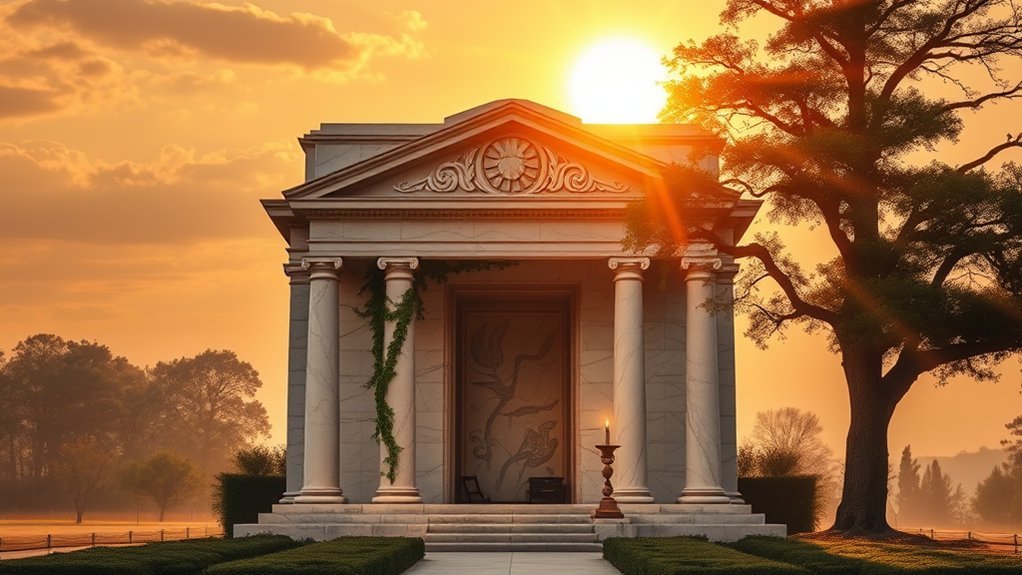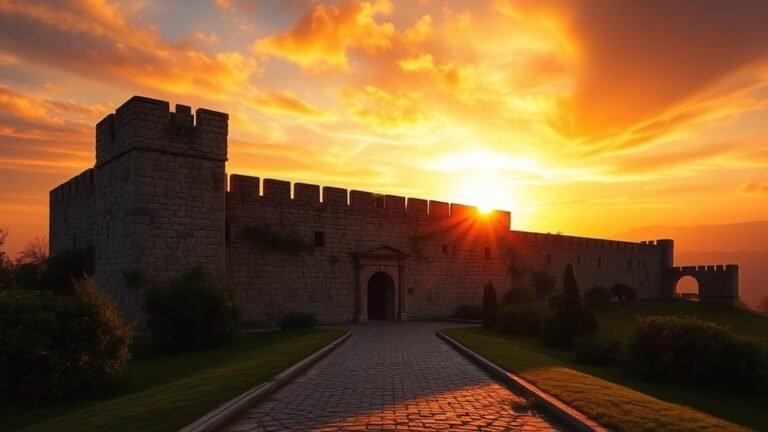12 Spiritual Meanings of Mausoleum
As we walk past the solemn structure of a mausoleum, we find ourselves drawn into a domain where mortality meets memory. Each stone whispers stories of love, loss, and legacy, prompting us to reflect on our own existence. It's a gentle reminder that life is transient, yet immortal in spirit. What deeper truths can we uncover within this sacred space that transcends the silence, offering us a profound connection to our shared humanity?
A Quick Overview
- Mausoleums symbolize the acknowledgment of mortality, prompting reflection on life's impermanence and our interconnectedness with others.
- They serve as monuments of eternal love, honoring the bonds and legacies that link generations through time.
- The intricate designs and carvings embody cultural heritage, representing historical significance and community ties.
- Mausoleums create spaces for collective remembrance, transforming grief into celebration through community rituals and ancestral connection.
- They facilitate personal introspection, allowing individuals to find solace and understanding amidst life's chaos while embracing their part in a larger narrative.
A Reminder of Mortality
As we stroll through the somber elegance of a mausoleum, we're gently reminded of our mortality. Each intricate carving whispers stories of lives once lived, urging us to pause and reflect.
These profound mortality reminders resonate deeply, inviting us to reconsider our life perspectives. We often rush, caught in the fleeting moments of daily existence, forgetting the inevitable cycle we all share.
In this sacred space, surrounded by silence, we feel a connection—a whisper of unity among souls, both past and present. It's here we discover that acknowledging our mortality isn't morbid; it's liberating.
Embracing this truth encourages us to cherish each day, to love fiercely, and to find belonging in the shared human experience. We're all travelers on this journey.
Symbol of Eternal Love
Countless mausoleums stand as enduring symbols of eternal love, capturing the essence of devotion that transcends time.
As we wander through these solemn structures, we feel the weight of an enduring bond that whispers of promises kept and love unyielding. Each stone tells a story, inviting us to reflect on our connections, reminding us that love doesn't vanish with mortality; it transforms, becoming a reflection of those we've cherished.
In this sacred space, we discover timeless devotion etched in marble, the silent echoes of hearts entwined beyond the earthly domain.
As we stand before these monuments, we're enveloped by the comfort of shared memories, finding solace in knowing that love, pure and true, is forever in bloom.
Marker of Legacy
Legacy whispers through the stone corridors of mausoleums, offering us a glimpse into the lives that once breathed vibrantly within them.
As we wander, we can't help but feel the weight of historical impact that these structures embody. They stand not just as tombs, but as monuments to the stories of love, ambition, and resilience.
With their architectural significance, they connect us to a time long past, urging us to reflect on our own place in this tapestry of existence.
Each ornate detail, each solemn inscription, invites us to honor those who shaped the world before us.
In this space of remembrance, we find a sense of belonging, a shared humanity that transcends time, beckoning us to cherish our own legacies.
Connection to Ancestors
When we step inside a mausoleum, we find ourselves enveloped in whispers of those who came before us, creating a bridge to our ancestors' lives.
Here, the walls resonate with stories, and we can't help but feel that ancestral connection deepening within us. Each name etched in stone becomes a thread in our shared tapestry, reminding us of our lineage remembrance.
In this sacred space, we're not just visitors; we're participants in a timeless conversation that binds generations.
With every moment spent in reflection, we honor their legacy and recognize our place within it.
We emerge, not just carrying their memories, but renewed in our understanding of who we are—a profound unity that transcends time and space.
Space for Reflection
As we step further into the mausoleum, the atmosphere becomes thick with stillness, inviting contemplation. Within these sacred walls, we find a refuge, a meditative space that beckons us to put aside the chaos of life.
It's here that we dive deep into personal introspection, revealing layers of our souls.
- We connect with our shared humanity.
- We honor memories that shape us.
- We nurture a sense of belonging.
In this ethereal sanctuary, time drips like candle wax, allowing thoughts to flow freely. Together, we explore the beauty of our existence, embracing our vulnerability.
Each moment spent here deepens our connection to those who came before us, whispering their wisdom into our hearts.
Spiritual Sanctuary
Though surrounded by the whispers of history, the mausoleum emerges as our spiritual sanctuary, inviting us to uncover the divine within ourselves.
In this sacred space, we find a spiritual refuge, a hushed stillness that embraces our wandering souls. We breathe in the fragrance of eternity and feel the weight of shared hopes and dreams, binding us together.
As we wander through these hallowed halls, we're reminded of our interconnectedness—a tapestry woven through time. Each step draws us closer to realization, illuminating hidden paths to our innermost selves.
Here, we're allowed to be vulnerable, allowing the echoes of the past to guide us toward a profound sense of belonging. Together, we discover that the mausoleum isn't merely a monument but a vessel of our spirit.
Representation of Transition
While we stand before the mausoleum, it becomes a poignant symbol of passage, marking the delicate threshold between life and the beyond.
This structure invites us to reflect on the changeover symbolism woven through our existence, reminding us that every end folds seamlessly into a new beginning.
As we acknowledge the intricate dance of life cycles, we find comfort in knowing we aren't alone on this journey.
- Each stone bears witness to stories of profound change.
- The serene stillness echoes our innermost fears and hopes.
- We grasp the continuity of existence, binding us through time.
Together, let's honor these sacred moments, embracing the transformations that guide us to the peace awaiting us.
Emphasis on Heritage
Mausoleums stand as monuments to our cultural heritage, reminding us that, even in death, we're woven into the fabric of our communities.
Their architectural beauty and design hold deep cultural significance, telling stories of those who shaped our past. Each stone, an echo of dreams and struggles, connects us to our shared history, inviting us to reflect on who we're and where we've come from.
As we explore their historical context, we uncover layers of identity, tradition, and collective memory. These sacred spaces teach us that our lives are interlinked, forming a rich tapestry of existence.
In their presence, we find solace and a sense of belonging, binding us together across generations.
Celebration of Life
As we gather around a mausoleum, we're reminded that it serves not just as a final resting place, but as a celebration of life—a tribute to the vibrant stories that once danced through the hearts of those interred within.
It's here that we find solace, stitching together the fragments of memory with love. In our shared moments, we honor their journeys through life celebration and remembrance rituals that resonate in our souls.
- We reflect on shared laughter and cherished dreams.
- We contemplate legacy and the impact of their existence.
- We ignite bonds that connect us in grief and joy.
Together, we weave a tapestry of connection, reminding ourselves that love transcends even the finality of death.
Appeal to the Divine
When we stand before a mausoleum, we may feel an invitation to reach beyond the veil of earthly existence, appealing to the divine in our search for meaning and connection.
In this sacred space, we sense the echoes of lives once lived, urging us to recognize the threads that bind us all. The stillness envelops us, offering solace, as we seek a divine connection that transcends time and form.
Each monument whispers secrets of love, loss, and hope, reminding us that we're not alone in our journey. Here, we embrace the sacredness of our shared humanity and the eternal quest for understanding.
In these moments, we're drawn together, inviting the divine into our hearts, forging an unbreakable bond.
Artistic Expression of Beliefs
Although we often think of mausoleums as mere structures of stone and marble, they embody an artistic expression of beliefs that transcends their physical form.
These monuments weave together threads of history, culture, and personal narratives, inviting us to ponder the deeper significance behind their intricate designs.
- Their artistic interpretations reflect the values and traditions of the communities they serve.
- They often symbolize resilience, love, and remembrance, encapsulating the essence of lives lived.
- Each element holds cultural significance, transforming mourning spaces into celebrated works of art.
As we stand before these grand edifices, we feel a profound connection to our past, embracing a sense of belonging crafted through artistry that resonates with our innermost beliefs.
Community and Collective Memory
Mausoleums stand as more than just impressive structures; they serve as anchors of community and collective memory.
Together, we gather in these sacred spaces, transforming grief into celebration through community rituals that echo our shared histories.
Each stone and inscription tells stories of those who came before us, offering us a tether to our roots and a pathway to deeper understanding.
As we honor the past, we weave our collective identity, binding us closer together, reminding us that we're part of something greater.
In moments of reflection, we discover how these mausoleums transcend individual loss, inviting us to embrace our communal journey.
They whisper the importance of remembering, nurturing a sense of belonging within each of us.
Frequently Asked Questions
How Does One Choose a Mausoleum Location?
When we choose a mausoleum location, we reflect on its significance, blending personal history with spiritual considerations. Together, we seek places that resonate with our hearts, embodying connections that nurture a sense of belonging and remembrance.
What Materials Are Commonly Used in Mausoleum Construction?
When we explore mausoleum construction, we find beauty in marble choices and granite options. Each material tells a story, connecting our shared journey with those we've loved, ensuring their memories endure in timeless elegance.
Are Mausoleums Personalized to Reflect Individual Beliefs?
Mausoleums can indeed be personalized, reflecting our unique beliefs through intricate designs and personalized engravings. Cultural influences shape these spaces, creating a profound sense of belonging that honors both individual identity and shared heritage.
What Is the Average Cost of Constructing a Mausoleum?
When we explore mausoleum financing options, we find that costs depend on materials and size. The mausoleum construction process can be both beautiful and personal, shaping our shared legacy in meaningful ways.
Can Mausoleums Be Visited by Anyone at Any Time?
Can we visit a mausoleum anytime? Often, we find beauty in mausoleum accessibility, but we should check specific visiting hours. Each glance offers a moment to connect, reflect, and understand our shared human journey.

Naomi White is an esteemed expert in spirituality with a passion for uncovering the hidden meanings and messages within divine symbols. Naomi’s work aims to bridge the gap between the mystical and the everyday, helping others find guidance and inspiration in the symbols that surround us all.







